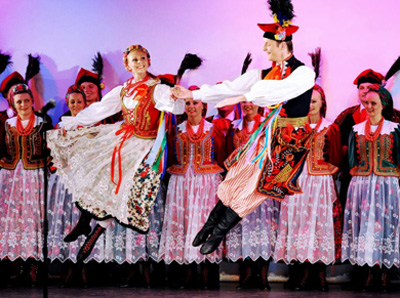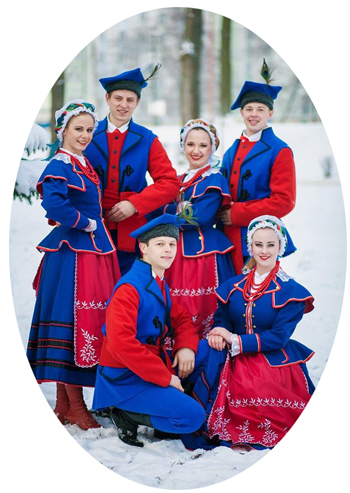Manners, Customs, Clothing
 |
 |
 |
 |
 |
 |
 |
Polish TFP Conforming to the Revolution
When I entered into contact with Catholic Tradition about 10 years ago through the disciples of Prof. Plinio Corrêa de Oliveira in Brazil, I could never have imagined seeing one of the TFP [Tradition, Family and Property] publications disseminating the lifestyle of a revolutionary family.
 In fact, friends from Poland recently sent me an email attachment of a recent issue of Polonia Christiana magazine (n. 57, 2018) whose front cover has little to do with a Catholic magazine. It looks more like a tourist publication featuring a family on a vacation trip to Africa – a family formed by a single child, a father and a mother who is wearing pants.
In fact, friends from Poland recently sent me an email attachment of a recent issue of Polonia Christiana magazine (n. 57, 2018) whose front cover has little to do with a Catholic magazine. It looks more like a tourist publication featuring a family on a vacation trip to Africa – a family formed by a single child, a father and a mother who is wearing pants.
The headline reads: “How to Relax in a Catholic Way?” Several other articles give tips to the reader on where to go for vacations and how to enjoy the trips.
After the initial shock of finding this photo in a TFP publication, I went to check Catholic doctrine on what it affirms about avoiding having a large family (here, here and here) and women dressing as men (here), which goes against the Commandments of God.
In parallel, I received from friends of Polish descent who live in Brazil a picture of dancers in the folkloric attire of the Krakow region, see photo below right.
One need not be gifted with great acumen to note the great ideological distance that separates the modern man – who tends toward tribalism and androgynism of which the masculinization of women is one phase – from the medieval man.
 I used to be a part of a Italian folkloric dance group and I witnessed the admiration people immersed in the modern world had for the clothing we wore, above all the delicate and beautiful details of the dress worn by the young women.
I used to be a part of a Italian folkloric dance group and I witnessed the admiration people immersed in the modern world had for the clothing we wore, above all the delicate and beautiful details of the dress worn by the young women.
I noted also the hatred of the boldest revolutionaries, particularly the homosexuals, when they looked at the folk dresses of the women and observed the courteous and chivalric way we men treated them while performing dances like the Italian tarantela. Those performances evoke customs strongly opposed to the blatant sensuality of the modern world.
This experience in my past helped me to understand the Revolution in the tendencies, which triggers changes in the ideas and facts.
It is through this tendencial revolution that the Revolution – with sagacity and intelligence – tries to change the mentalities and ways of being that Christian Civilization shaped and forged in men through centuries of seriousness, mortification, purity and honor. These elements constituted the marks of society in the Middle Ages, which was governed by the wisdom of the Gospel, as Pope Leo XIII affirmed.
Thus we see how the Revolution is not spontaneous; to the contrary, it has meticulously followed a plan to influence and change society for the last 500 years. Clearly, the revolutionaries we find in the sacristies and universities never confess this fact. They do not want to be unmasked.
The Sexual Revolution and Feminism are battlefronts of the present day phase of the Revolution. And if the approval of divorce and homosexual “marriage” has advanced, it is only because public opinion had been previously prepared by the Cultural Revolution to accept these aberrations.
Conservatives may appear to be walking slowly on the path of the Revolution, but the revolutionary knows that they will eventually fully change their ideas and ways of being through the influence of the tendencial revolution. It is understandable that many Catholics are not aware of this revolutionary strategy, but, for the disciples of Plinio Corrêa de Oliveira, it is unacceptable not to know it. They should be ashamed of such ignorance.
Returning to that issue of the Polonia Christiana, I also found the article “Plastermiodu, lilia i bomba” by Dr. Plinio, which translates – if I am not mistaken – as “The honeycomb, the lily and the bomb,” an article first published in Brazil (Folha de São Paulo, June 6, 1987).
 In that article about the approval of divorce in Brazil, Prof. Plinio commented: “But I must add that the greatest catastrophe in this matter was not – nor does it continue to be –divorce, but rather the terrible dissolution of customs that has gradually and inexorably been propagated in our country for many years. This is the root cause. The approval of divorce is just one of its catastrophic effects.”
In that article about the approval of divorce in Brazil, Prof. Plinio commented: “But I must add that the greatest catastrophe in this matter was not – nor does it continue to be –divorce, but rather the terrible dissolution of customs that has gradually and inexorably been propagated in our country for many years. This is the root cause. The approval of divorce is just one of its catastrophic effects.”
He continued: “For the restoration of the indissolubility of marriage, it is necessary to first restore in countless souls a longing for seriousness, austerity and mortification. Yes, and also for something else, which is expressed by a word as sweet as a honeycomb and as perfumed as a lily and that, nonetheless, detonates today like a bomb. That word is purity. It is followed closely by its two sisters, no less sweet, no less gentle, but with a an even greater power of explosion. They are virginity and honor.”
The photo-illustration on the front cover of Polonia Christiana, considered under the light of the principles just enunciated, is nothing less than a great affront to Prof. Plinio’s counter-revolutionary school of thought. For that article tacitly induces the reader to accept today’s vulgarity of customs expressed in the dress and ways of being of those three persons on the cover. It also prompts the reader to wonder if the boy is the only child of the couple, which implies that the couple practices contraception.
One sees that there is a cultural and moral relativist message wrapped in that photo, which is precisely the opposite of what one should expect from those who are called to be the spearhead of the Counter-Revolution.
In brief, the message on the cover of this issue of Polonia Christiana is in blatant contrast with the principles that inspired many years of commentaries by Prof. Plinio in his Ambiences, Customs & Civilizations column in the monthly Catolicismo.



Promoting - not fighting - the Cultural Revolution
The headline reads: “How to Relax in a Catholic Way?” Several other articles give tips to the reader on where to go for vacations and how to enjoy the trips.
After the initial shock of finding this photo in a TFP publication, I went to check Catholic doctrine on what it affirms about avoiding having a large family (here, here and here) and women dressing as men (here), which goes against the Commandments of God.
In parallel, I received from friends of Polish descent who live in Brazil a picture of dancers in the folkloric attire of the Krakow region, see photo below right.
One need not be gifted with great acumen to note the great ideological distance that separates the modern man – who tends toward tribalism and androgynism of which the masculinization of women is one phase – from the medieval man.

Polish folk dancers from the Krakow region
in traditional dress

I noted also the hatred of the boldest revolutionaries, particularly the homosexuals, when they looked at the folk dresses of the women and observed the courteous and chivalric way we men treated them while performing dances like the Italian tarantela. Those performances evoke customs strongly opposed to the blatant sensuality of the modern world.
This experience in my past helped me to understand the Revolution in the tendencies, which triggers changes in the ideas and facts.
It is through this tendencial revolution that the Revolution – with sagacity and intelligence – tries to change the mentalities and ways of being that Christian Civilization shaped and forged in men through centuries of seriousness, mortification, purity and honor. These elements constituted the marks of society in the Middle Ages, which was governed by the wisdom of the Gospel, as Pope Leo XIII affirmed.
Thus we see how the Revolution is not spontaneous; to the contrary, it has meticulously followed a plan to influence and change society for the last 500 years. Clearly, the revolutionaries we find in the sacristies and universities never confess this fact. They do not want to be unmasked.
The Sexual Revolution and Feminism are battlefronts of the present day phase of the Revolution. And if the approval of divorce and homosexual “marriage” has advanced, it is only because public opinion had been previously prepared by the Cultural Revolution to accept these aberrations.
Conservatives may appear to be walking slowly on the path of the Revolution, but the revolutionary knows that they will eventually fully change their ideas and ways of being through the influence of the tendencial revolution. It is understandable that many Catholics are not aware of this revolutionary strategy, but, for the disciples of Plinio Corrêa de Oliveira, it is unacceptable not to know it. They should be ashamed of such ignorance.
Returning to that issue of the Polonia Christiana, I also found the article “Plastermiodu, lilia i bomba” by Dr. Plinio, which translates – if I am not mistaken – as “The honeycomb, the lily and the bomb,” an article first published in Brazil (Folha de São Paulo, June 6, 1987).

Polish Catholics dressed as knights attract youth after a Latin Mass in Kloster Einsieldeln, Switzerland
He continued: “For the restoration of the indissolubility of marriage, it is necessary to first restore in countless souls a longing for seriousness, austerity and mortification. Yes, and also for something else, which is expressed by a word as sweet as a honeycomb and as perfumed as a lily and that, nonetheless, detonates today like a bomb. That word is purity. It is followed closely by its two sisters, no less sweet, no less gentle, but with a an even greater power of explosion. They are virginity and honor.”
The photo-illustration on the front cover of Polonia Christiana, considered under the light of the principles just enunciated, is nothing less than a great affront to Prof. Plinio’s counter-revolutionary school of thought. For that article tacitly induces the reader to accept today’s vulgarity of customs expressed in the dress and ways of being of those three persons on the cover. It also prompts the reader to wonder if the boy is the only child of the couple, which implies that the couple practices contraception.
One sees that there is a cultural and moral relativist message wrapped in that photo, which is precisely the opposite of what one should expect from those who are called to be the spearhead of the Counter-Revolution.
In brief, the message on the cover of this issue of Polonia Christiana is in blatant contrast with the principles that inspired many years of commentaries by Prof. Plinio in his Ambiences, Customs & Civilizations column in the monthly Catolicismo.

A relativist message wrapped
in the cover photo

Posted October 17, 2018
______________________
______________________








